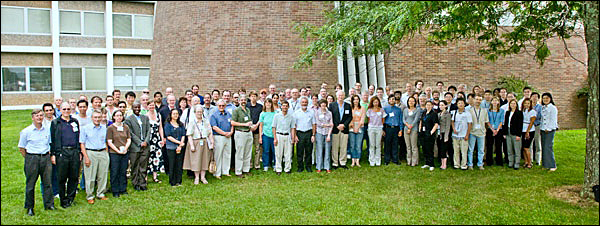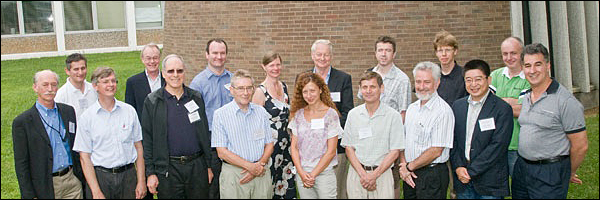Tiny, Powerful Beams Will Enable New Science: Workshop Makes Case for Micro-Beams
September 1, 2009
At next-generation synchrotron light sources, tiny, powerful x-ray beams — especially of sub-micron size — could substantially advance research in several areas of structural biology, particularly macromolecular crystallography (MX). Such was the consensus of the approximately 100 participants at the “MX Frontiers at the One Micron Scale” workshop held at BNL on July 23 and 24. Workshop talks also illuminated the benefits that micro-beams will offer for the mitigation of radiation damage; however, all agreed that more experimental verification and method development is needed.

Participants at the 2009 MX Frontiers Workshop
The workshop was particularly relevant given the development of National Synchrotron Light Source II (NSLS-II), a brilliant new synchrotron facility under construction at BNL. The unusually substantial list of interested sponsors for the workshop included the NSLS-II Project, BNL’s National Synchrotron Light Source (NSLS), the Office of Biological & Environmental Research and the Office of Basic Energy Sciences in the DOE Office of Science, Brookhaven Science Associates, BNL’s Biology Department, the National Institutes of Health’s National Center for Research Resources, and the National Institute of General Medical Sciences. Commercial support was provided by FMB-Oxford Ltd, Bruker ASC, and Area Detector Systems Corporation.
As he welcomed participants on the first morning of the workshop, Laboratory Director Sam Aronson highlighted the essential role played by the crystallography community at the NSLS and expressed his hopes for their continued involvement in leveraging the expanded capabilities of NSLS-II. During the workshop, organized by BNL’s Dieter Schneider, Marc Allaire, and Lonny Berman, speakers on the first day lectured about scientific opportunities, new crystallographic methods, radiation damage, and micro-focusing beamlines. The next day was devoted to beamline concepts and challenges in optics and instrumentation. Posters were displayed on both days for viewing and discussion during coffee and lunch breaks.
Aptly, the workshop allowed speakers and participants to weigh in on how recent developments in crystallography may be used to inform the design of beamlines at NSLS-II. Workshop speakers and participants underscored the importance of incorporating full-automation and beamlines with the flexibility to deliver a stable one micron beam as well as larger beams. Regarding the future at NSLS-II, Wayne Hendrickson, NSLS-II Associate Project Director for Life Sciences, predicted that “what we think of as difficult today will become routine by 2015.”
David Eisenberg of UCLA illustrated just this development by discussing his adventures in micro-crystallography that led to the discovery of the mis-folded state of amyloid peptides that cause Alzheimer’s and related diseases. He anticipates that increasingly brilliant x-ray beams and continued advances in micro-techniques will eventually allow him to investigate amyloid crystallites in vivo, inside intact cells. Christian Riekel, his longtime collaborator and a pioneer in microdiffraction, expanded these views and outlined the ideas that he and his colleagues apply in advancing from micro- to nano-diffraction methods.

Speakers and organizers of the workshop were (front, from left) Dieter Schneider,* BNL; Gebhard Schertler, MRC Laboratory for Molecular Biology, UK; David Eisenberg, University of California at Los Angeles; Christian Riekel, European Synchrotron Radiation Facility (ESRF), France; Irene Margiolaki, ESRF; Colin Nave, Diamond Light Source, UK; Robert Fischetti, Argonne National Laboratory; Masaki Yamamoto, RIKEN Harima Institute, SPring-8, Japan; Lonny Berman,* BNL; (back, from left) Marc Allaire,* BNL; Wayne Hendrickson, Columbia University; James Holton, Lawrence Berkeley National Laboratory; Elspeth Garman, University of Oxford, UK; John Spence, Arizona State University; Gwyndaf Evans, Diamond; Clemens Schulze-Briese, Swiss Light Source; and Sean McSweeney, ESRF. Not in the photo are speakers Kenneth Evans-Lutterodt, BNL; and Antonio Lanzirotti, BNL. (*workshop organizers)
In addition to considering new ideas for NSLS-II, some speakers shared current developments and future plans for other synchrotron facilities, including the Advanced Photon Source at Argonne National Laboratory, the European Synchrotron Radiation Facility (ESRF) in Grenoble, France, the Swiss Light Source in Switzerland, the Diamond Light Source in England, and SPring-8 facility in Japan. By bringing together scientists from such widespread facilities, the workshop also provided a unique opportunity in scientific community building.
“To address issues that will come up in the next five to 10 years, we need to find better ways to integrate and share access to beamlines,” said Sean McSweeney of ESRF, emphasizing the value of cooperative development. Likewise, Gebhard Schertler, MRC Laboratory of Molecular Biology, Cambridge, UK, indicated, “It is important how beamline scientists work with other scientists — they have to work on equal terms.”
The workshop concluded with a final discussion considering the key question of whether or not a solid case had been made in favor of micro-beams. Participants debated the matter with enthusiasm throughout, deliberating the appropriateness of the one-micron scale, the role of sub-micron beams, and the usefulness of beamlines with flexible capabilities.
Although as Colin Nave of Diamond pointed out, “We’re not yet in the position where all the possibilities have been explored.”
Ultimately, the sum of lectures and discussions clearly illustrated that tiny beams will enable new science, particularly so if the beam is of sub-micron size. At this scale, structural work will be characterized by experimentation rather than routine measurements and involve many pursuits in life sciences such as MX, small-angle x-ray scattering, and fiber diffraction, and potentially borrowing from electron microscopy. Finally, the workshop illuminated the benefits that micro-beams offer for the mitigation of radiation damage, but that more experiments must be done and methodologies developed to ensure that micro-beams are used to their best advantage.
For more information on the workshop, see the NSLS wrap-up story.
Story by Nicole Puglin
2009-1375 | INT/EXT | Newsroom









